Dollar Stores, Peso Stores & other Enigmas…
By Irina Echarry, photos: Caridad

HAVANA TIMES, Oct. l4 -You get to know a city by roaming its streets, speaking with its people, discovering the cracks in the asphalt, observing its businesses…
Oh, the businesses in Cuba!
“Dollar stores” and bodegas form part of the country’s commercial network, with shops that are large and small, central and more remote. What mark the difference are the products sold and the public to whom they are directed.
Bodegas-those shops in which the ration book plays the leading role when making a purchase-have a look of poverty that is unimaginable for anyone from another country, accustomed to stores (big or small, it doesn’t matter) with wide selections.
Sure, such outlets also exist here, and the image of Havana changed completely when those establishments opened. They are well-stocked and fully supplied places that are maintained that way despite the island being hit by numerous hurricanes.
However, to buy something in them the ration book serves no purpose. You have to bring “Convertible Pesos” (CUCs)-hard currency pegged to the US dollar, Euro and other currencies. But since 25 National Pesos equal just one Convertible Peso, our currency is humiliated by the mighty CUC, the one that is not used to pay the wages of people who get up every day to make their contribution to society.

So, there are two currencies: one that you get paid in and the other (which you have to acquire through different roads) that serves to buy needed products.
Isn’t it possible to have another alternative to improve the lives of workers? Must mediocrity and poor taste reign, as if there isn’t space in our bodegas for anything else? Can’t some of the products offered in the fancy stores be offered at a more moderate price and-above all-in national currency?
The dollar stores reflect a similar story. You only have to look in the window to know what currency is required.
Sometimes you find only empty windows in the stores that sell to low-income workers (those who don’t receive money from family members abroad or who don’t have businesses that generate income in the other currency-the hard one).
Yes, “we are a blocked country” (etc.). Notwithstanding, what is incomprehensible is when the windows or their broken down shops sell articles that have fallen into disuse or are in poor condition.
“Fin de Siglo” (End of the Century) is one of the most famous stores of Havana. In it are concentrated a wealth of useless items. I can only imagine that they hope someone will happen along to purchase these items to create a museum of disposable, non-recyclable goods?

This store stocks plastic, rubber and aluminum items that were used at one time -but now; in 2009 they serve no purpose. They are prominently displayed on the first floor of the store – but why? To take up space? To waste someone’s time and money if they figure they can use them for something? To strip us of self-respect?
Maybe it’s simply a way to decorate the place. When we get used to poor taste, everything else looks good. Other stores sell broken umbrellas, shoes that nobody will ever buy, and clothes that nobody will ever wear – given the tasteless styles and poor materials. This is what you find available for sale in national currency.
Wouldn’t it be better to strike a balance, to achieve equilibrium between the two types of stores? Our people deserve much more than bad taste and scarcity. Maybe it’s necessary to dedicate time and concern to the issue…ah, and a little imagination.
Click on the thumbnails to see all the photos in this gallery





























“Wouldn’t it be better to strike a balance, to achieve equilibrium between the two types of stores?”
Unfortunately, that would mean LOWERING the quality of CUC stores, and doing THAT would just drive away tourists and their badly needed funds.
A dual economy is not an ideal situation but the consequences of making ANY changes should be carefully studied to avoid unintended catastrophic results.
I hear that the ration book may be eliminated in favour of slightly higher wage compensation. I believe the next step would be to eliminate the dual currency system that clearly discriminates against the worker without any other means. Wages and prices in Cuba in the moneda nacional have not kept pace with the rest of the world. Imports have to be paid for in convertible currency and hence items are either highly priced in CUC stores or highly subsidized (if made available) in the bodegas. The next step would be to introduce market reforms aimed at creating accountability in state enterprises and greater choice and availability for consumers. If done properly, this would have the effect that wages and prices would find their proper level. This needs to be done carefully to avoid transitional hardships that could have political implications, such as was experienced by the Eastern Bloc countries. In those cases, much of the socialism that was built was destroyed with much pain.